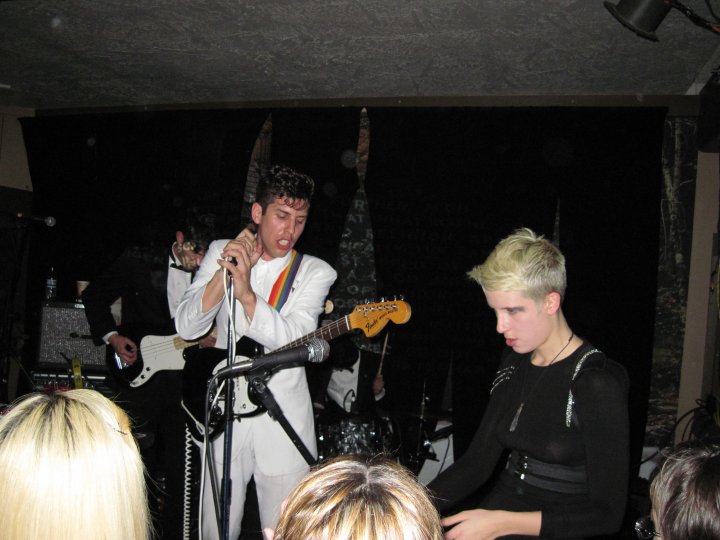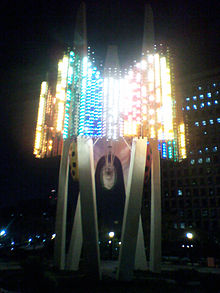“Renaissance man”, like genius, is a bestowed label that gets overused. There are far more Leonardo Ninja Turtles out there in the world than there are Leonardo Da Vincis. That isn’t the case with the duo of Claire Evans and Jona Bechtolt, the polymath brains behind YACHT. Not only has the pair released astonishing albums and music videos, they’ve also demonstrated a deep appreciation for and interest in science, film, technology, extraterrestrial phenomenon, and art. Working as journalists, writers, editors, and multimedia artists, they’re forward-thinking creatives who also know how to put on one hell of a live show.
YACHT have cruised through Phoenix on many occasions in the past. They’re scheduled to perform this Saturday at Viva PHX (along with the likes of Fucked Up, X, Girl Talk, and Joyce Manor). I got a chance to talk to Bechtolt and Evans on the phone before their Viva PHX appearance about their current projects, their love of Ridley Scott’s Alien, and the challenges that come with playing music festivals.
On your website, it lists Viva PHX as your only upcoming live performance. What made you want to come out and do the festival?
CLAIRE EVANS: Generally speaking, we’re not playing a lot of shows right now because we’re recording and working on other projects. But we couldn’t say no to Viva Phx because we love Phoenix.
JONA BECHTOLT: We’re also doing a live film score of the movie Alien for LACMA.
That sounds fantastic! How did that opportunity arise?
JONA: It’s a new series they’re doing called Bring the Noise, where there’s a curator who’s asked a handful of artists to do live scores. It’s headed by Elvis Mitchell, this amazing film critic, and T-Bone Burnett. They asked us what movie we wanted to do; originally, we had a different choice in mind, but they couldn’t clear the rights. So, Alien was our second choice because we’re huge science fiction fans and that movie is pretty much perfect.
CLAIRE: We watched all the Alien movies last week, so I can tell you that the first and the second ones are the best ones.
What was the original film you wanted to do, the one they couldn’t clear the rights for?
CLAIRE: We wanted to do the original Westworld, the movie the TV show is based on, which is actually kind of a weird, interesting, not-great movie from this cool era of American 70’s sci-fi cinema. But it was complicated; there are many different rightsholders, so we couldn’t get it. Which is fine, because Alien is way better.
JONA: It is a better movie, but I was excited about Westworld. The music in that movie really sucks, so it would have been an easy job to make it sound better and elevate the movie. Alien is great because it’s a deep challenge- everybody knows that movie and has a relationship with it, so it’s going to be hard to make something as good as the original, or at least not pull too much focus away from it.
Most of the live film scores I’ve experienced tend to be for silent films. It seems like scoring for a film with dialogue would pose all sorts of additional challenges.
JONA: You gotta have lots of cues and stuff, so you know when to play and when not to play. The first movie in the series was Welcome to the Dollhouse, which is a movie that we both love. It was scored by Hunx & His Punx’s Seth Bogart. And he did an amazing job. He actually scored the garage band scene too, where the kid is playing, so that was an interesting call.
CLAIRE: The curators are giving us a copy of the film with just the dialogue; the music’s taken out so we don’t have to worry about the levels being balanced. It’ll be as if you’re watching the real movie.
I’ve seen you play twice in the Valley before, at Black Forest Mill and the Crescent Ballroom. At both shows, I was really blown by the high-energy of your performances and how you integrated video projections into your set. I was wondering: in a festival environment, where you have to work in the midst of 40 other bands, do you still do those kinds of performances? Or do you have to do a more stripped down version of it?
CLAIRE: We try to push every context to its limit. It’s a lot easier to get people feeling like they’re a part of something really dynamic and fun when its part of a contained environment. Within the constraints of a traditional rock and roll style club, that’s a lot easier to do. A festival is a challenge in its own way- it’s difficult sometimes if you’re playing in the middle of the day, or you don’t have your whole setup that you’re used to having. But it really makes it more challenging in a fun way. How can you make a situation like that — where everything is equalized and everyone has the same amount of time onstage- how can you make yourself stand out, how you can make people have an experience with you that they don’t have with other people? I think, ultimately, it comes down to a connection with the audience and being willing to get weird and get intimate and get physical and come off the stage sometimes… to just push and question the context as much as possible.
Your music videos are really distinctive. They all seem to be of a piece. A lot of bands, their music videos just feel like the band is being plugged into some random director’s vision. Your videos seem to be very much in tune with your identity and philosophy as a group. So I was wondering how involved you are in that process? How closely do you work with the people who make your videos?
CLAIRE: Very!
JONA: Yeah.
CLAIRE:100% input. We’re REALLY uptight about having things exactly like that- I’m really happy you made that observation because it’s something that we care about. Making our entire output, not just videos, not just music, everything- the merchandise, the website, the appearance, the photography – all of it should feel like it comes from one creative fountainhead.
JONA: Because it does. It’s not that we feel like those things are tasks that we HAVE to do- we have ideas for everything.
CLAIRE: All that stuff that surrounds being a band are opportunities to convey something. Whether it’s to extend the message of a song or extend the message of the band as an entity, it’s fun to dabble in all the different media to try and make that message consistent. Plus – we’re just control freaks. We’ve been doing this for so long… we come from a punk/D.I.Y background where we had to do everything by ourselves for 10 years of our band-
JONA: -We can’t imagine letting anyone else do anything for us like that. With directors and photographers and stuff like that, from the beginning, we have to make sure that they understand that we’re going to be super controlling and have ideas at every turn.
CLAIRE: I think that we always pick our collaborators very carefully. We always pick people that we think are capable of doing things that we cannot do or who can push our vision or our parameters in an interesting way.
So this is a total film nerd question… “Psychic City” is one of my favorite music videos. I watch it all the time. And I was wondering if the filmmaker Sergei Parajanov was an influence on it?
CLAIRE: No, we don’t know that filmmaker. What are some of his movies?
His most famous work is The Color of Pomegranates.
CLAIRE: Oh, I’ve heard of that!
His movies have this weird tableaux style, where all the action by the actors is done with them directly facing the camera. It reminded me of how y’all are set up in “Psychic City.”
CLAIRE: Huh. No, that’s not an influence.
JONA: It must be, subconsciously.
CLAIRE: It can’t be subconsciously if we haven’t seen it yet… I love when people project influences onto our stuff, though.
In past interviews, you’ve talked about how you like to keep mum about your future projects as a band. I was wondering if you’d be up for talking about what’s influencing your current work, or would that be spoiling things?
CLAIRE: Ooh, how can we answer that without revealing anything?
JONA: We can talk about other projects too. Claire is writing a book. We’re also working with a group to restore a giant and crazy piece of public art here in Los Angeles. In 1975 it was the world’s largest instrument and the world’s first polyphonoptic instrument. It’s a giant sculpture that is light and sound together. It’s been kind of dormant for the past decade and a half, so we’ve put together this coalition that’s just received a $100,000 grant to restore this crazy thing. Right now our brains are seeded in a lot of 70’s color therapy and light installations and the artists doing that kind of stuff.
CLAIRE: We’ve always been interested in the intersection of art and technology and music. It always guides what we do. In the context of this Triforium project, it’s about respecting our elders and respecting how incredible the shift in technology has been for the last 40 years. This thing we’ve been working on was built on a computer system in 1975. It was really visionary at the time, but now it’s a monolith, basically. It’s Stonehenge. We’re just mindful and blown away by our position in time right now, by how much we can actually do, even at our level as artists and consumers. What we have access to is remarkable. In terms of our other project, which is top secret, we’re really exploring the bleeding edge of what can be done with technology and music.
JONA: And Claire’s book is about internet history. We’re looking back a lot right now. Looking back and cherry-picking the best things about the past to create a better future.
Ashley Naftule is a writer, performer, and lifelong resident of Phoenix, AZ. He regularly performs at Space 55, The Firehouse Gallery, Lawn Gnome Books, and The Trunk Space He also does chalk art, collages, and massacres Billy Idol songs at karaoke. He won 3rd place at FilmBar’s Air Sex Championship in 2013. You can see more of his work at ashleynaftule.com
For more Phoenix coverage that doesn’t suck, follow PHX SUX on Suckbook and that tweety website for Twits.
Read more from PHX SUX:







